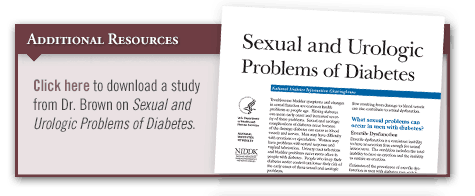Sexual and urologic complications among men and women with diabetes have historically received relatively little attention from clinicians. Diabetes impacts the function and structure of the lower urinary tract, including the bladder and prostate. Studies suggest that urologic complications resulting from diabetes may be even more common than that of widely recognized microvascular complications, such as retinopathy, neuropathy, or nephropathy.
“Diabetes can lead to different types of sexual and urologic complications in both men and women,” says Jeanette S. Brown, MD (Table 1). “These include urinary incontinence (UI), poor bladder emptying, sexual dysfunction, lower urinary tract symptoms (LUTS), and urinary tract infections (UTIs). Treatment options are available for many of these sexual and urologic complications. Unfortunately, these problems often go unaddressed because patients oftentimes will not discuss these issues with their clinicians.”
Caring for Women: Lower Urinary Tract Symptoms
Urinary incontinence has been estimated to be more common in women with type 2 diabetes than in women with normal glucose levels (Table 2). There is also evidence that women with pre-diabetes are at higher risk for incontinence. The clinical diagnosis of UI—and more broadly, LUTS—is typically based on a variety of factors, and Dr. Brown says that clinicians can be proactive by paying attention to patient complaints when they arise. “It can often be difficult for women to speak up when they develop issues like UI, LUTS, or UTIs, but we should be asking them about these symptoms regularly during office visits,” Dr. Brown says. “When symptoms are identified, we can then take that opportunity to educate patients about the possible treatment options that are available to manage these problems.”
Intensive lifestyle interventions have been shown to decrease the prevalence of UI in overweight and obese women at risk of diabetes. Eating a healthy diet, exercising regularly, quitting smoking, engaging in good diabetes self-care practices, and taking medications as prescribed can help keep urologic and sexual problems under control. “Women who are vigilant about managing their diabetes tend to have fewer urologic problems and sexual complications,” adds Dr. Brown. “That said, much remains to be learned regarding the prevention of sexual dysfunction in women with diabetes. We can help women manage complications when they occur, but the key is to drive home the importance of good diabetes care practices at each visit.”
Caring for Men: LUTS & Benign Prostatic Hypertrophy
In men with diabetes, common urologic complications include LUTS and benign prostatic hypertrophy (BPH). Studies have shown that LUTS occur more frequently among men with diabetes, with an estimated 25% increased risk of LUTS in those with the disease when compared with men who have normal glucose levels. Similarly, men with diabetes more commonly have BPH. “The interplay of LUTS, BPH, and diabetes remains unclear, but studies suggest that there is a connection,” says Dr. Brown. “Clinicians should be sure to monitor men with diabetes for these symptoms and directly ask about these complications.”
Erectile dysfunction (ED) is also common in men with diabetes. Researchers have estimated that 23% to 90% of men with diabetes have ED. The cause of diabetic ED is multifactorial and still unclear, but studies have shown that several comorbid conditions appear to play a role, including aging, poor glycemic control, hypertension, cardiac disease, obesity, and a lack of exercise. Experts recommend that treatment of ED begin with weight loss, regular exercise, smoking cessation counseling, and adoption of a healthy diet before using oral medications, injections, or other more serious therapies. If a psychological component is present, sex therapy counseling may be beneficial.
Fostering Communication With Patients
Dr. Brown says that healthcare providers should be alert for urologic complications and sexual dysfunction among their patients with diabetes because they are common and often unrecognized. “For many patients, these problems go undertreated for a long time, which in turn reduces their quality of life,” says Dr. Brown. “Clinicians sometimes focus mainly on managing glucose, blood pressure, and cholesterol levels in patients with diabetes. These components of disease management are critical, but we cannot lose sight of managing sexual and urologic problems. Opening communication lines with patient education materials and information on these sexual and urologic problems may engage patients to discuss these matters more freely when they occur.”
Efforts to prevent sexual and urologic complications among patients with diabetes are of substantial importance to public health, Dr. Brown says, but more research is needed. “We need to learn more about the mechanisms of these complications and effective treatment and prevention strategies,” she says. “As this information emerges, we hope to decrease the psychosocial, medical, and economic costs of these chronic disorders in many men and women with diabetes.”




 admin
admin